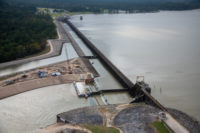Innovative Roller Compacted Concrete Dam Opens in Puerto Rico

When the heavy rains come as they do every year, the steep mountain slopes on the southern side of Puerto Rico can become deadly. The Portugués and Bucana rivers often overflow with a rapidity that threatens the municipality of Ponce downstream.
The formal completion ceremony for the $386-million Portugués Dam on Feb. 5 marks the end of a long odyssey to solve the flood-control issues that imperil the Caribbean island's second-largest urban area. The 220-foot high structure is the first single-centered, roller compacted concrete (RCC), thick-arch dam, ever attempted by the US Army Corps of Engineers, according to project officials.
The dam, along with a companion structure on the Bucana River completed in 1991, will protect more than 1,800 acres from flooding that is home for approximately 40,000 residents. The U.S. federal government underwrote three-fourths of the project's cost with the government of Puerto Rico paying the rest. A transfer of the Portugués Dam to the commonwealth is slated for next year.
The structure, which was mostly completed in late December, has a crest length of 1,230 feet and includes a 145-ft crest spillway. Dragados USA won the construction contract for the dam in 2008 with a bid of $180 million and began work later that same year. All told, building the Portugués Dam required more than 367,000 cubic yards of RCC work and 60,000 cu yd of excavation.
The dam is designed to use water impoundment to limit flooding on the river and keep water flow to a steady level. Plans for a flood-control project to protect Ponce began in the 1940s, with detailed studies being launched in the mid 1960s. The project was approved in 1970, and work on the channels and the companion Cerrillos Dam on the Bucana River were completed by 1991.
The unorthodox decision to make the RCC dam using the heavy-arch design is due to an extended delay in the project due to cost concerns, said Pablo Vazquez-Ruiz, the resident construction engineer for the Corps in Ponce.
Initially, the Corps chose a three-centered double-curvature thin-arch dam as ideal for the Portuguese project. Work on the dam began in the mid-1990s with 350,000 cubic yards of material removed and construction starting on the foundation structure. Despite the progress, financial concerns brought the effort to a halt in 1999.
The Portugués Dam project was put out to bid in 2000, but when only one proposal was submitted at a price considerably over the government’s cost estimate, the project was shelved again. The Corps then launched a new approach by completely re-examining the project using software tools unavailable when the project was originally launched and accounting for newer construction methods.
“In this case, we had already invested quite a bit of money in excavation and foundation preparation,” says Vazquez-Ruiz of the Corps. “When we redesigned the dam, we tried to save as much of the work already done on the ground.”
The result was the innovative heavy-arch design using RCC methods. While the approach was “like going back to square one” in terms of design, the cost savings were significant enough to warrant it, Vazquez-Ruiz says. By placing the concrete in 12-inch layers and eschewing the need for rebar, the time to complete the project was dramatically reduced.
Ironically, the delay in the construction of the Portugués Dam turned out to be an advantage.
“The RCC technology was not available to implement at the time the first plans were made,” says Jose Pena, one of the design engineers at the Corps' Jacksonville District office. “So when we moved into the second design, and the ability to do it was there, we moved forward.”



